What's New Under The Sun
Madison Historic Dial Returns
Monday, 13 October 2025 22:49
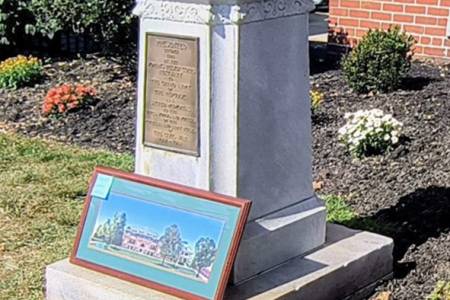 On October 4, 2025 Madison Historical Society of Ohio was able to have their sundial returned after 32 years, when in 1993 it was moved to the lawn of Lake County Courthouse to reduce the chance of vandalism. The sundial was originally placed at Madison Home 100 years ago on Saturday, October 24, 1925 during a conference of the Women's Relief Society. From 1904 to 1962 the state ran this...
On October 4, 2025 Madison Historical Society of Ohio was able to have their sundial returned after 32 years, when in 1993 it was moved to the lawn of Lake County Courthouse to reduce the chance of vandalism. The sundial was originally placed at Madison Home 100 years ago on Saturday, October 24, 1925 during a conference of the Women's Relief Society. From 1904 to 1962 the state ran this...
Elements of Dialing Course - 2025
Monday, 15 September 2025 19:42
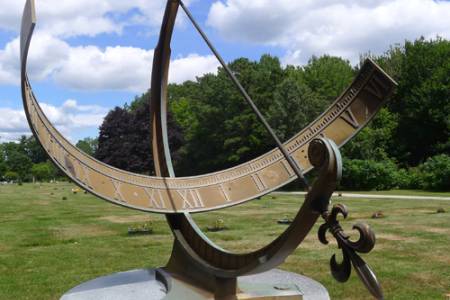 NASS is pleased to announce the upcoming fifth instance of Elements of Dialing, our introductory course about sundials, their history, and the science that makes them work. The free 12-lesson course, intended for those are new to sundialing, runs from 27 October 2025 until 26 April 2026. The course instructor is Robert Kellogg, NASS Vice President and Sundial Registrar. Bob will be...
NASS is pleased to announce the upcoming fifth instance of Elements of Dialing, our introductory course about sundials, their history, and the science that makes them work. The free 12-lesson course, intended for those are new to sundialing, runs from 27 October 2025 until 26 April 2026. The course instructor is Robert Kellogg, NASS Vice President and Sundial Registrar. Bob will be...
Sun Queen of World War II
Thursday, 11 September 2025 23:11
 A Hungarian born American scientist, Mária Telkes (1900-1995), was called "The Sun Queen" and among other honors, was postmousthly inducted into the National Inventors Hall of Fame. She lived to 95 and for most of her life developed solar power in a variety of forms.
Trained as a biophysicist, she worked for Westinghouse Electrical and Manufacturing Company in Pittsburgh, PA, where she...
A Hungarian born American scientist, Mária Telkes (1900-1995), was called "The Sun Queen" and among other honors, was postmousthly inducted into the National Inventors Hall of Fame. She lived to 95 and for most of her life developed solar power in a variety of forms.
Trained as a biophysicist, she worked for Westinghouse Electrical and Manufacturing Company in Pittsburgh, PA, where she...
2025 Conference -Ottawa
Thursday, 28 August 2025 23:25
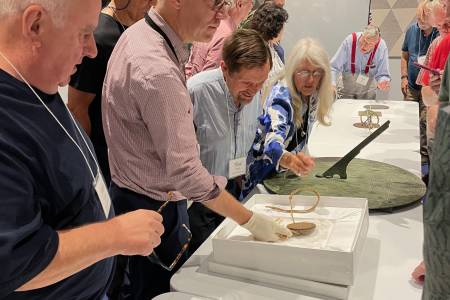 The annual NASS Conference was held 7-10 August, 2025 in Ottawa. As usual, the conference began late Thursday afternoon with an introduction social and a "grab bag give away", taking your chances with tickets to win the bag's prize. Will Grant was the final winner of the Walton Double Planar Polar Sundial, but Paul Ulbrich beat the statistic odds and won this prize three times,...
The annual NASS Conference was held 7-10 August, 2025 in Ottawa. As usual, the conference began late Thursday afternoon with an introduction social and a "grab bag give away", taking your chances with tickets to win the bag's prize. Will Grant was the final winner of the Walton Double Planar Polar Sundial, but Paul Ulbrich beat the statistic odds and won this prize three times,...
Prosciutto di Portici Sundial's Owner
Tuesday, 10 June 2025 18:51
 Prosciutto di Portici (Ham) Sundial
Photo: Getty Images
The Prosciutto di Portici Sundial, more often called the Portici Ham Sundial, dates from the first century somewhere between 8 BCE to 79 CE. This small silvered bronze dial was uncovered on 11 June, 1755 in the ruins of Herculaneum (current day Portici) in the "Villa of the Papyri", buried in...
Prosciutto di Portici (Ham) Sundial
Photo: Getty Images
The Prosciutto di Portici Sundial, more often called the Portici Ham Sundial, dates from the first century somewhere between 8 BCE to 79 CE. This small silvered bronze dial was uncovered on 11 June, 1755 in the ruins of Herculaneum (current day Portici) in the "Villa of the Papyri", buried in...
Hamilton Dial Dedicated
Friday, 06 June 2025 21:01
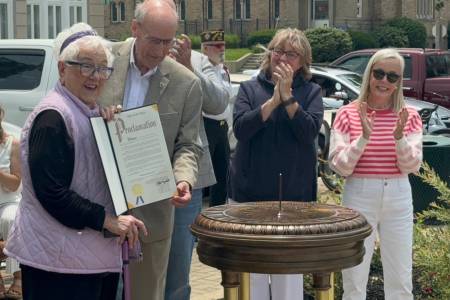 Sundial dedication May 31, 2025. At left is Kathleen Stuckey Fox, with the City Proclamation presented by Mayor Pat Moeller and City Council on-lookers Carla Fiehrer and Susan Vaughn offering congratulations.
On May 31, 2025 at 1pm, the Hamilton, Ohio, sundial (NASS Sundial Registry #1109) was re-dedicated in Monument Park. Originally dedicated in 1941 to the...
Sundial dedication May 31, 2025. At left is Kathleen Stuckey Fox, with the City Proclamation presented by Mayor Pat Moeller and City Council on-lookers Carla Fiehrer and Susan Vaughn offering congratulations.
On May 31, 2025 at 1pm, the Hamilton, Ohio, sundial (NASS Sundial Registry #1109) was re-dedicated in Monument Park. Originally dedicated in 1941 to the...
Frans Maes Received a Royal Decoration
Monday, 24 March 2025 21:33
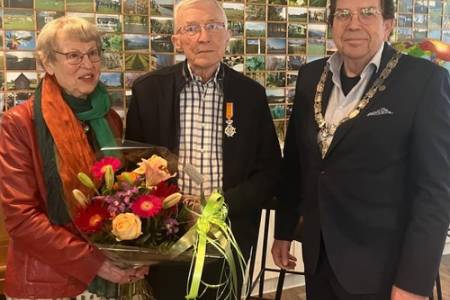 Several years ago Frans decided to write the course on sundials that included self assessment questions to force students not only to read the text, but to internalize the concepts. And a final submittal question "not necessarily a difficult question, but: no answer, no new lesson." Thus Frans Maes began writing lessons and sending them out to students.
NASS has now used his material to create...
Several years ago Frans decided to write the course on sundials that included self assessment questions to force students not only to read the text, but to internalize the concepts. And a final submittal question "not necessarily a difficult question, but: no answer, no new lesson." Thus Frans Maes began writing lessons and sending them out to students.
NASS has now used his material to create...
Pros and Cons of Daylight Savings Time
Monday, 24 March 2025 15:37
 In a 24 March 2025 article from the on-line Science Advisor (American Association for the Advancement of Science) Phie Jacobs summarizes the "great debate" of the yearly shift from standard time to daylight savings time. In January 2025 the US Senate introduced the Sunshine Protection Act to permanently have daylight savings time year round. Certainly 54% of Americans do not like the...
In a 24 March 2025 article from the on-line Science Advisor (American Association for the Advancement of Science) Phie Jacobs summarizes the "great debate" of the yearly shift from standard time to daylight savings time. In January 2025 the US Senate introduced the Sunshine Protection Act to permanently have daylight savings time year round. Certainly 54% of Americans do not like the...
Native American Moon Alignment Ring
Friday, 21 March 2025 19:26
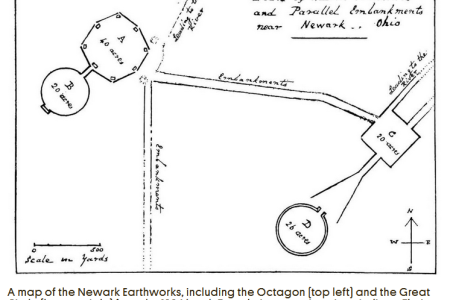 Perhaps the most famous alignment circle in the United States is the Cahokia Woodhenge near St. Louis constructed between 700-1400 CE by Cahokia Indigenous native Americans. But there were an estimated 10,000 other earthen mounds that once were scatter across the mid-west..
In an article from Atlas Obscura (https://www.atlasobscura.com/articles/octagon-earthworks-ohio) by Olivia Young on March...
Perhaps the most famous alignment circle in the United States is the Cahokia Woodhenge near St. Louis constructed between 700-1400 CE by Cahokia Indigenous native Americans. But there were an estimated 10,000 other earthen mounds that once were scatter across the mid-west..
In an article from Atlas Obscura (https://www.atlasobscura.com/articles/octagon-earthworks-ohio) by Olivia Young on March...
Hamilton Dial under Restoration
Friday, 21 March 2025 18:37
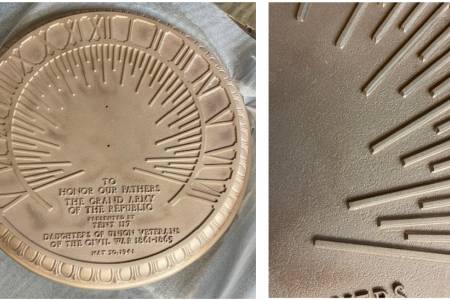 The Hamilton dial is in the restorative care of Jarrett and Celene Hawkins (Hawkins & Hawkins Custom, LLC in Cincinnati Ohio https://www.studio-hawkins.com/) in preparation for the dial's dedication on Saturday, May 31, 2025.
The face of the Hamilton Grand Army of the Republic (GAR) sundial has been cleaned and bead-blasted showing the dial as it was cast 84 years ago. In the process,...
The Hamilton dial is in the restorative care of Jarrett and Celene Hawkins (Hawkins & Hawkins Custom, LLC in Cincinnati Ohio https://www.studio-hawkins.com/) in preparation for the dial's dedication on Saturday, May 31, 2025.
The face of the Hamilton Grand Army of the Republic (GAR) sundial has been cleaned and bead-blasted showing the dial as it was cast 84 years ago. In the process,...
VSSC Space Museum gets Polar Sundial
Tuesday, 17 December 2024 23:47
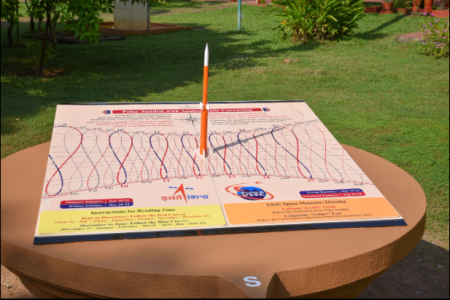 In November 2024, a team consisting of members from SPL, TTDG and CMD of VSSC successfully designed and installed an accurate and fully functional sundial at the Rocket Garden of VSSC Space Museum, Thumba (8.53°N, 76.86°E). Following a space theme, the vertical gnomon is a 3-stage rocket that casts its daily and seasonal shadow on a dial face 1 1/2 meters by 1 meter. The the sundial face...
In November 2024, a team consisting of members from SPL, TTDG and CMD of VSSC successfully designed and installed an accurate and fully functional sundial at the Rocket Garden of VSSC Space Museum, Thumba (8.53°N, 76.86°E). Following a space theme, the vertical gnomon is a 3-stage rocket that casts its daily and seasonal shadow on a dial face 1 1/2 meters by 1 meter. The the sundial face...
Historic Sundials of Andalusia
Saturday, 16 November 2024 00:07
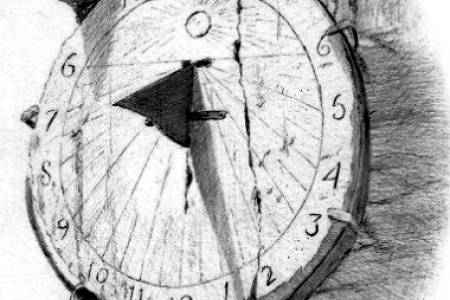 Esteban Martínez Almirón has published a new book Historical Sundials: Forgotten Andalusian Treasures (Relojes de Sol Históricos Tesoros Andaluces Olvidados) In it he reviews over 400 sundials from the Andalucian region of southern Spain Originally to celebrate the 25th year of the website https://relojandalusi.org/
Esteban Martínez Almirón began showing his sundial drawings on the site....
Esteban Martínez Almirón has published a new book Historical Sundials: Forgotten Andalusian Treasures (Relojes de Sol Históricos Tesoros Andaluces Olvidados) In it he reviews over 400 sundials from the Andalucian region of southern Spain Originally to celebrate the 25th year of the website https://relojandalusi.org/
Esteban Martínez Almirón began showing his sundial drawings on the site....
2021 Conference - Philadelphia
- Details
- Hits: 7450
The North American Sundial Society, after by-passing the 2020 Conference due to Covid restrictions, held the 26th annual meeting from August 5th - 8th at the Hilton Garden Inn, Center City, Philadelphia. The venue was similar to past conferences: Thursday night social and door prizes for attendees, Friday a bus tour of 11 sundials in the Philadelphia area, Saturday sundial presentations and annual dinner, finishing on Sunday with more sundial presentations and the annual general meeting (AGM).The dial tour took us walking through Philadelphia parks and arboratums and visits to University of Pennsylvania, Swarthmore College, and Haverford College.
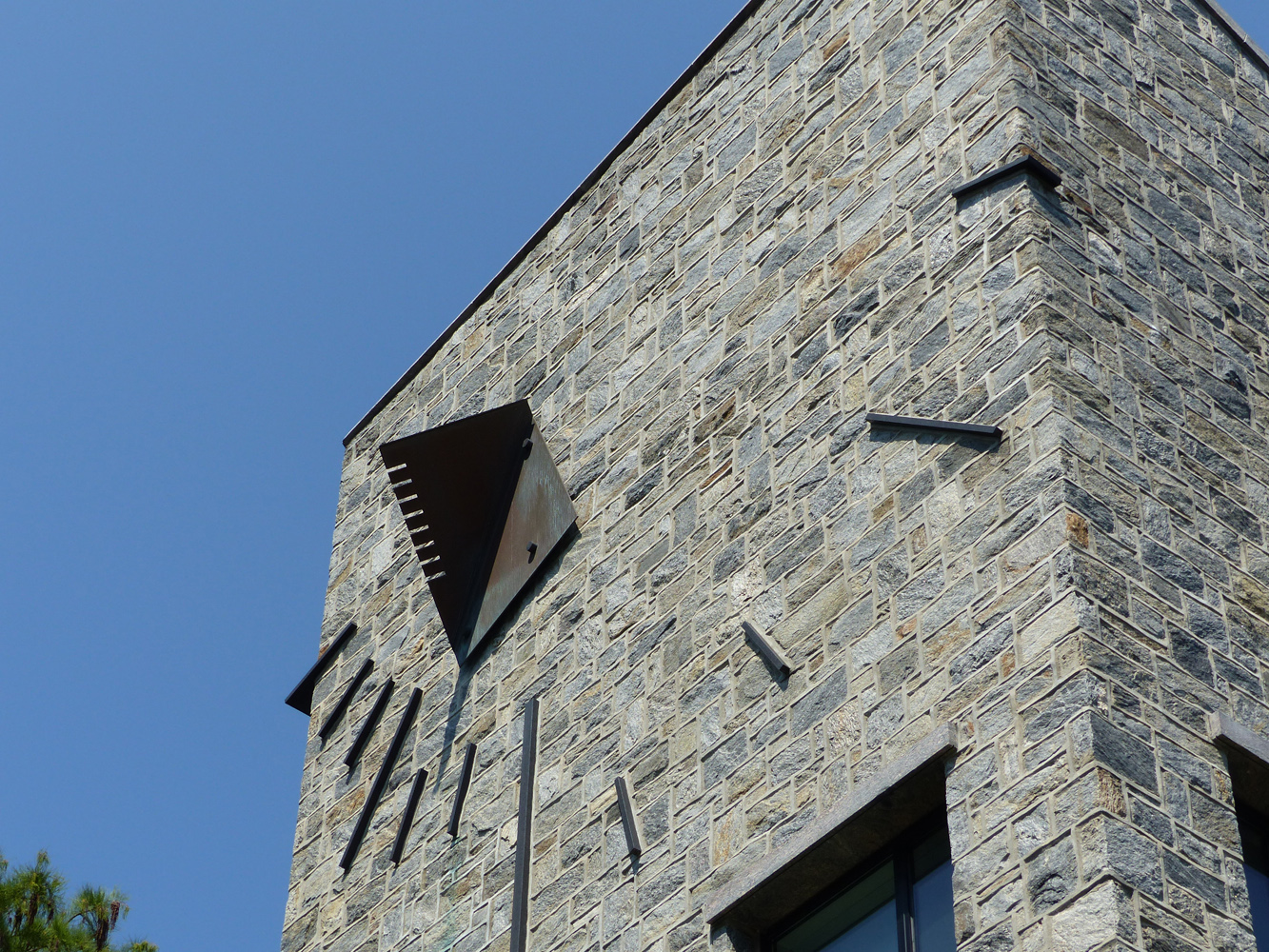 At Swarthmore we saw the modern vertical declining dial on Kohlberg Hall, designed by Martin Cowan. Frederick Orthlieb, professor and chair of the Dept of Engineering at Swarthmore "had a part in locating the bent-plate gnomon so as to give correct indications on the vertical wall. As installed, the gnomon's indicating edge (which lies on a Polar Axis) casts quite a short shadow in Autumn and Winter and requires some observing skill to make a close estimate of indicated time, but in Spring and Summer the longer shadow moves over the granite hour marks very plainly."
At Swarthmore we saw the modern vertical declining dial on Kohlberg Hall, designed by Martin Cowan. Frederick Orthlieb, professor and chair of the Dept of Engineering at Swarthmore "had a part in locating the bent-plate gnomon so as to give correct indications on the vertical wall. As installed, the gnomon's indicating edge (which lies on a Polar Axis) casts quite a short shadow in Autumn and Winter and requires some observing skill to make a close estimate of indicated time, but in Spring and Summer the longer shadow moves over the granite hour marks very plainly."
For the annual group photo attendees gathered around the "Point Where Things Change", a N-S meridian dial commissioned in 2001 by the Redevelopment Authority of the City of Philadelphia and designed by Michael Grothusen. The dial is on the grounds of Tasepoint Corporate Headquarters.
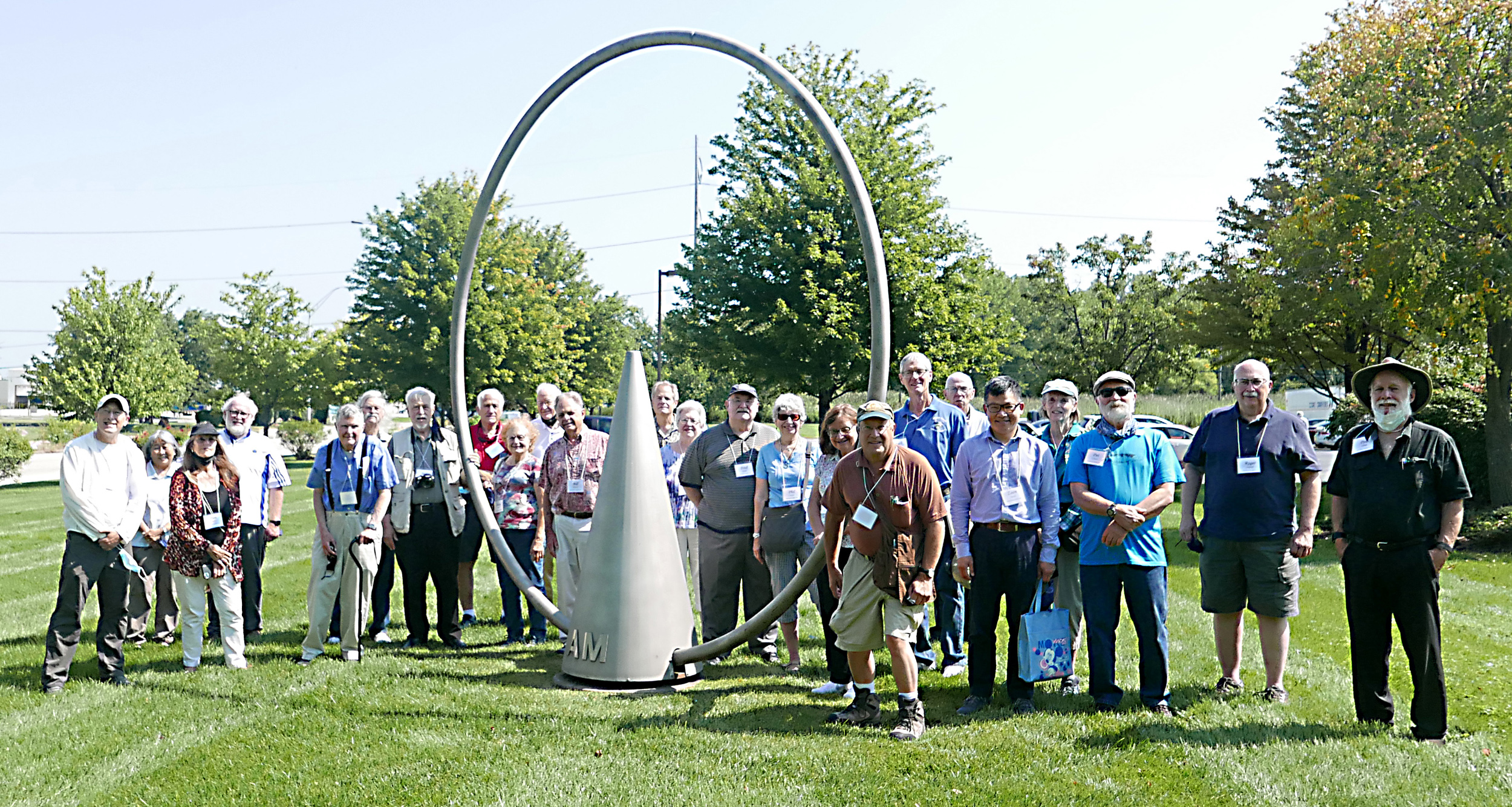
From Left to Right: Bill Gottesman, Joyce Robinson, Pam Morris, David Robinson, Bob Kellogg, George Wilson, Jack Aubert, Will Grant, Betsy Wilson, Jim Holland, Bill Thibault, Art Paque, Tish Grant, Fred Sawyer, Philomena Sawyer, Phyllis Montgomery, Jeff Kretsch , Mark Montgomery, Marvin Taylor, Zoon Nguyen, Kate Aubert, Pat O'Hearn, Roger Dignard, Paul Ulbrich.
3D Printing Tutorials
- Details
- Hits: 13393
 Look for the new menu tab:3D Printing Tips. Starting this December (2019) NASS begins a series of tutorials using OpenSCAD and other software for designing and printing 3D objects. As you might guess, we'll focus on creating sundials and other shadow casting objects. Download your copy of OpenSCAD at http://www.openscad.org and join our tutorials. If you want even more detail on 3D sundials, join NASS and receive The Compendium with Bill Gottesman, Steve Lelievre, Bob Kellogg and others writing in the regular column "3D Design and Printing Sundials."
Look for the new menu tab:3D Printing Tips. Starting this December (2019) NASS begins a series of tutorials using OpenSCAD and other software for designing and printing 3D objects. As you might guess, we'll focus on creating sundials and other shadow casting objects. Download your copy of OpenSCAD at http://www.openscad.org and join our tutorials. If you want even more detail on 3D sundials, join NASS and receive The Compendium with Bill Gottesman, Steve Lelievre, Bob Kellogg and others writing in the regular column "3D Design and Printing Sundials."
Seattle Sundial Tribute
- Details
- Hits: 25543
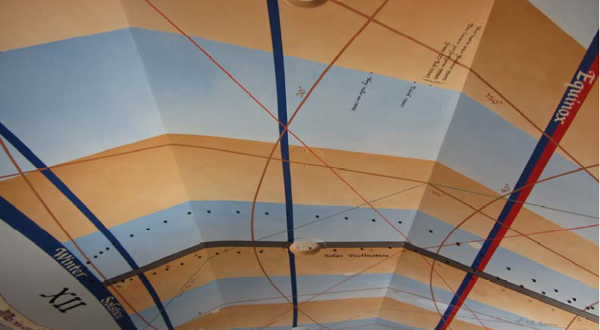
Professor Woody Sullivan's Reflection Dial
[photo - NASS Conference 2011]
|
Professor Woody Sullivan of the University of Washington in Seattle, whose long time motto has been "Seattle, sundial capital of North America", received a tribute from local television station King5 for sundials that he has designed or brought to light around Seattle. His pride and joy is his ceiling reflection dial [photo at left] As related by Joan Kinsey from King5 news, "It took Sullivan and an artist three years to chart hundreds of reflected dots across the top of Sullivan's remodeled garage..." The celestial view includes hour lines, solar declination lines of the equinox and the soltices, and a variety of transit dots that represent special dates and times to the Sullivan family.
Sullivan, a professional astronomer, has helped design a number of Seattle dials. As Joan Kinsey notes, "His first one [a declining vertical dial] went up in 1994 on the side of the astronomy building at the university ...The huge wall sundial ignited Sullivan's passion to make more and research the ones that already exist in town." Woody has created a Sundial Trail of prominent Seattle dials ranging from several vertical dials increasing the educational value at local schools to a large Shepard's dial and an occulus gnomonic dial.
Of course being Seattle, Woody scribed an appropriate sundial motto, "I thrive in the sun, Can't work in the rain. So, if I'm beclouded, please come back again. "
Read about it at: king5 news
Native American Moon Alignment Ring
- Details
- Hits: 4071
Perhaps the most famous alignment circle in the United States is the Cahokia Woodhenge near St. Louis constructed between 700-1400 CE by Cahokia Indigenous native Americans. But there were an estimated 10,000 other earthen mounds that once were scatter across the mid-west..
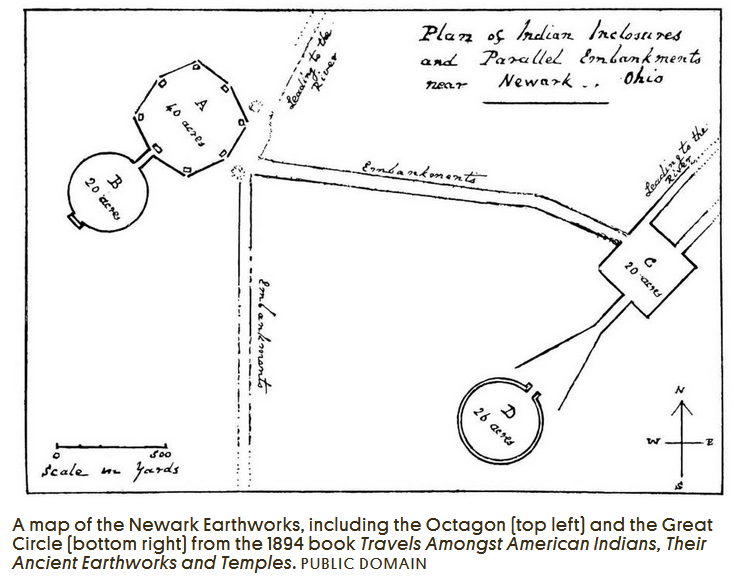 In an article from Atlas Obscura (https://www.atlasobscura.com/articles/octagon-earthworks-ohio) by Olivia Young on March 5, 2025:
In an article from Atlas Obscura (https://www.atlasobscura.com/articles/octagon-earthworks-ohio) by Olivia Young on March 5, 2025:
"Just outside of Ohio’s capital, a wall of earth rises five feet from the smooth ground in a perfect circle,1,000 feet (305m) wide. Standing inside that ring of mounded terra firma today, you can see the Moon rise right where the walls break and an ancient passageway leads to an enormous octagonal arena. Thousands of years ago, the Native Americans who built it would have been standing in that very spot, watching the same celestial scene." This is the position of the lunar standstill, the farthest north that the moon rises in the sky and occurs every lunar cycle of 18.6 years.
"The significance and sophistication of the Octagon Earthworks has been compared to that of Stonehenge and the pyramids in Giza. Despite that, the 2,000-year-old site was leased to a country club and used as a golf course for more than 100 years—up until January 1, 2025. After more than a decade of negotiating the Ohio History Connection (OHC) took over the lease and opened the sacred landmark to the public."
Dr. John Low, director of the Newark Earthworks Center at Ohio State Univ. noted that, "At the start of the 1800s, there were more than 40 tribes in what is now Ohio, including the Shawnee, Kickapoo, and Miami. By 1842, they had all been forcibly removed under the Indian Removal Act." But the indigenous people's vibrant culture and astronomical precision remains in their earthen mounds. Since 2023 this and other indigenous earthworks have been designated by UNESCO as a World Heritage Site (the Hopewell Ceremonial Earthworks), including the Octagon and Alignment Ring.
Ancient Egyptian Clock
- Details
- Hits: 5308
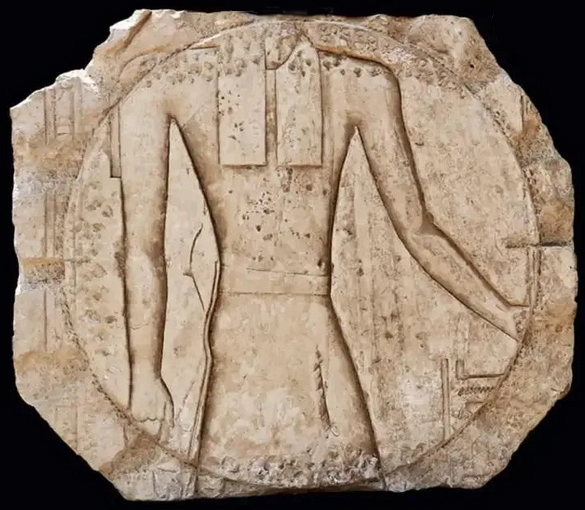 Dario Radley reports in Archaelogical News Online Magazine (Aug 24, 2024) that an ancient observatory from the 6th century BCE was found by the Egyptian Supreme Council of Antiquities at Tell El-Fara'in archaeological site.
Dario Radley reports in Archaelogical News Online Magazine (Aug 24, 2024) that an ancient observatory from the 6th century BCE was found by the Egyptian Supreme Council of Antiquities at Tell El-Fara'in archaeological site.
“It highlights the advanced astronomical knowledge of the ancient Egyptians, including their ability to determine the solar calendar and significant religious and agricultural dates,” Dr. Mohamed Ismail Khaled, Secretary-General of the Supreme Council of Antiquities, told Ahram Online.
Archaeological News Online further reported: One of the key findings at the site is an inclined stone sundial, known as a shadow clock, which was used to measure time based on the sun’s position. This sundial consists of a straight row of limestone slabs, approximately 4.80 meters long, with several vertical and horizontal blocks that may have been used to measure the angle and shadow of the sun throughout the day. Dr. Ayman Ashmawy, head of the Egyptian Antiquities Sector at the Supreme Council of Antiquities, described this sundial as one of the most significant artifacts found, illustrating the Egyptians’ skill in timekeeping and their understanding of solar movements.
Read the full article at:https://archaeologymag.com/2024/08/astronomical-observatory-discovered-in-kafr-el-sheikh/
Pleistocene Sunburst Pocket-Art Unearthed
- Details
- Hits: 12025
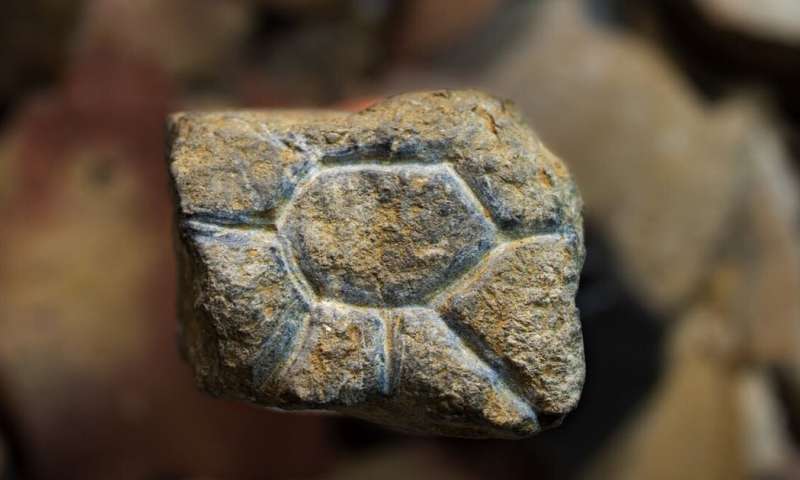 Photo Credit: Andrew Thompson Photo Credit: Andrew Thompson |
Archaeologists have found two miniature stone engravings in a cave on the island of Sulawesi in Indonesia. One plaquette appears to be a sunburst, the other an ibex like animal, the anoa. These pocket-sized carvings dating back between 14,000 and 26,000 years. Elsewhere in Sulawesi the oldest cave art dating to 44,000 years ago was recently discovered, dispelling the Euro-centric notion of Pleistocene art.
Examining the incisions cut into the ancient flowstone, the Sunburst hexegon outline was carved starting in the photo from upper left, with continuing connecting lines done clockwise. Then the 7 rays were added. Small traces of a red mineral (perhaps red ochre pigment) exist in some of the sunburst cuts, possibly indicating that the sun was enhanced in a beautiful red color. Before this discovery the oldest known depiction of the sun was from the Nebra sky disk found in Germany and fabricated of metal 3,600 years ago, rivaling Pharaoh Akenaten who built a whole city to the glory of the sun (Aten) 3,365 years ago. These are recent times compared to the sunburst.
The archaeology team was lead by Michelle C. Langley of the Australian Research Centre for Human Evolution, Griffith University, with associates at Arkeologi Nasional (ARKENAS), Jakarta, Balai Arkeologi Sulawesi Selatan and Balai Pelestarian Cagar Budaya in Makassar. They report in Nature Human Behaviour "... the discovery of two small stone ‘plaquettes’ incised with figurative imagery dating to 26–14 ka from Leang Bulu Bettue, Sulawesi. [The pocket-art was discovered in a cave and rockshelter complex of Leang Bulu Bettue (4° 59' 31.18" S, 119° 40' 5.53" E) situated at the foot of a limestone tower in the Maros-Pangkep karst area.] These new findings, together with the recent discovery of rock art dating to at least 40 ka in this same region, overturns the long-held belief that the first H. sapiens of Southeast Asia–Australasia did not create sophisticated art and further cements the importance of this behaviour for our species’ ability to overcome environmental and social challenges."
The artefacts reported here are currently curated at the Australian Research Centre for Human Evolution, Griffith University, Nathan, Australia. They will return to Indonesia at the conclusion of the project where they will be given accession numbers and be curated in Makassar by Balai Arkeologi Sulawesi Selatan.
Read more at:
Hemicyclium Sundial Discovered in Turkey
- Details
- Hits: 17793
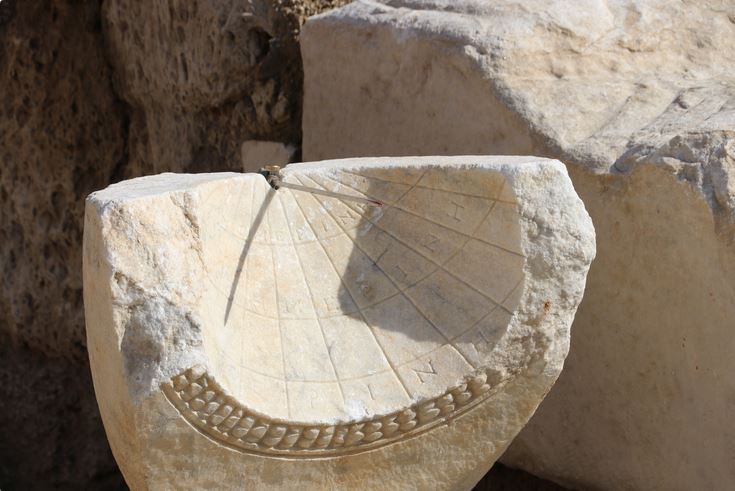 Several years ago in 2017 archaeologists found a rare hemicyclium sundial. Now another hemicyclium in excellent condition has been unearthed in Turkey's city of Denizli. Celal Şimşek, chief archaeologist at Denizli's Pamukkale University, calls it "unique". A better word is rare. Less than a hundred examples of this type of Hellenistic sundial have survived. It was found in the ancient city of Laodicea about 370 miles south of Istanbul. The sundial seems to have come from the archaeological site of one of the temples. As reported in the Daily Sabah, "Among the rare, largely preserved buildings in the city are the largest ancient stadium in Turkey, a theater and a sacred agora." The hemicyclium of pink marble has an outer edge decorated in foliage while the interior hemisphere has the traditional Greek names of the seasons. Hour lines deliniate the time. Almacantor lines show the solstices and a great circle marks the equinox. In AA Photo of the sundial at right, a needle gnomon has been restored to show how the sundial casts a shadow. Time and season are read at the gnomon shadow's tip.
Several years ago in 2017 archaeologists found a rare hemicyclium sundial. Now another hemicyclium in excellent condition has been unearthed in Turkey's city of Denizli. Celal Şimşek, chief archaeologist at Denizli's Pamukkale University, calls it "unique". A better word is rare. Less than a hundred examples of this type of Hellenistic sundial have survived. It was found in the ancient city of Laodicea about 370 miles south of Istanbul. The sundial seems to have come from the archaeological site of one of the temples. As reported in the Daily Sabah, "Among the rare, largely preserved buildings in the city are the largest ancient stadium in Turkey, a theater and a sacred agora." The hemicyclium of pink marble has an outer edge decorated in foliage while the interior hemisphere has the traditional Greek names of the seasons. Hour lines deliniate the time. Almacantor lines show the solstices and a great circle marks the equinox. In AA Photo of the sundial at right, a needle gnomon has been restored to show how the sundial casts a shadow. Time and season are read at the gnomon shadow's tip.
Read more at: https://www.dailysabah.com/life/history/2000-year-old-sundial-unearthed-in-southern-turkeys-denizli
ADDENDUM FROM SUNDIAL DIGEST - 10 April 2020
I would like to add two arguments to the questions [of the sundial's age] under discussion:
1. Prof. Şimşek said: “On the North Parados passage in the Western Theater, which dates back to the Hellenistic Era, in the ancient city we have found a spherical sundial facing south, which we believe to be 2,020 years old.
This is a kind of conclusion which does not help by dating the dial. A comparison with similar specimens reveals that it was probably done around 200 – 400 CE.
2. “Inscribed on the dial are the Greek word ‘Ksimerini’, or winter on the upper part; ‘Isimerini’, or solstice, which denotes the equality of day and night in the middle; and ‘Terini’, or summer in the bottom.”
I read (ΤΡΟΠH) ΧΕ(Ι)ΜΕΡΙΝH / IΣΗΜΕΡΙΝH / (ΤΡΟΠH) ΘΕΡΙΝH.
These are the names of the solstices and the equinoxes. What is conspicuous is the missing of I in χειμερινή (it should be written with diacritic signs). That is another strong argument that it was done in the Roman era.
With best wishes
Karlheinz Schaldach
Sundial Discovered in Madaba Map Mosaic
- Details
- Hits: 13528
We've reported on ancient mosaics from Turkey showing sundials (Antioch Mosaic Sundial - 2016). Now from the Ministry of Sciences and Higher Education in Poland ( Archaeology News - Ancient Sundial and Science in Poland ) another ancient mosaic sundial has been discovered:
Sundial in the Madaba Map, a great mosaic located in Jordan. The sundial is located next to the gate on the left. Credit Wikipedia/public domain.
Professor Marek T. Olszewski from the University of Warsaw was re-examining a number of mosaics dating back to the 2nd century AD when he made his startling discovery.
One of the mosaics from the 6th century AD which was discovered by the Gate of Damascus in Jerusalem, Olszewski noticed that between a richly dressed women, a mysterious object is visible, which scientists at the beginning of the 20th century described as an oil lamp or column.
Olszewski said: ”After careful analysis and comparison with a sundial discovered during excavations, I came to the conclusion that this mosaic and other ones similar to it depict sundials....
Another sundial "tracked" by the Polish researcher is located in a wall mosaic in Santa Cecilia in Trastevere church in Rome. This mosaic was created during the time of Pope Paschal I (817-824).
Prof. Olszewski also noticed a previously unknown sundial in the Madaba Map - a huge floor mosaic, which is currently stored in the church of St. George in Madaba, Jordan. It shows a map of the Middle East from the Byzantine period. This is the oldest cartographic depiction of the Holy Land, including Jerusalem and dates back to the 6th century AD.
Yet another depiction of a sundial comes from Tarsus (Mersin) in Turkey, where a figural mosaic (ca. 2nd-3rd century AD) shows a sundial on a column and a crow sitting on it. A man tries to scare off the bird by throwing a pouch at it (crow was a symbol of a bad omen).
Professor Olszewski has now discovered eight previously unknown sundials in the designs, taking the total number known to 15.
Time and Cosmos
- Details
- Hits: 15275
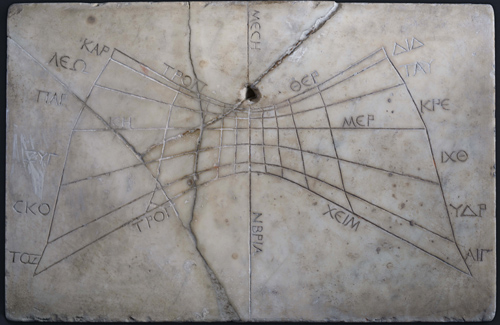
Horizontal Gnomonic Dial (Inv. 3075)
by permission
Museo Archeologico Nazionale di Napoli
|
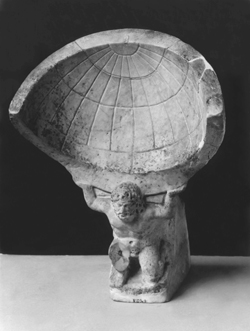
Statuette of Atlas Bearing a Hemispherical Sundial
by permission
Sir John Soane's Museum, London
|
The Institute for the Study of the Ancient World (15 East 84th Street in New York) is hosting an exhibition "Time and Cosmos in Greco-Roman Antiquity" open to the public from now until April 23, 2017. From their on-line invitation, "This exhibition aims to explore the ways that time was organized and kept track of in the Greco-Roman world, and how it was conceived in relation to the Cosmos. The objects displayed include artifacts illustrating the technology of ancient time-reckoning and the perception, visualization, and social role of time and cosmos..." This is exemplified by a wonderful horizontal gnomonic sundial using a vertical gnomon shown at left. It was found at Pompeii around 1865 and became part of the Museo Archeologico Nazionale di Napoli in 1867. "Despite the fact that it was found in Italy, the inscriptions on it are in Greek, perfhaps reflecting the status of Greek as the langauage of science in antiquity. The summer and winter tropics (solstices), equinox, and seasons are reasonably declined. The hour lines however reflect temporal hours rather than the hour angles we would draw todayl.
